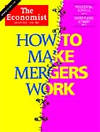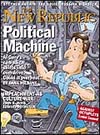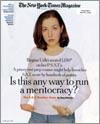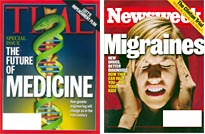
Economist, Jan. 9
(posted Saturday, Jan. 9, 1999)
Noting that mergers increased 50 percent worldwide in 1998 and that less than half of mergers "add value," the cover article advises companies how to make successful marriages. Suggestions: Don't merge because you're bored with your own company, don't merge because you're scared, watch out for antitrust law, and make sure your corporate cultures are compatible. ... A piece chronicles the horrific implosion of Sierra Leone, where an "incoherent," horrible guerrilla movement is sweeping through the countryside, destroying what little remains of civil society. Many of the soldiers are kidnapped children; some practice cannibalism. ... A piece describes the next cool tool of the U.S. military: microplanes. Six inches long, weighing 3 ounces, and equipped with tiny cameras, they will spy on enemy positions. The prototypes fly like insects rather than like planes.
Vanity Fair, February 1999
(posted Saturday, Jan. 9, 1999)
The cover article and photo essay preview the new Star Wars movie, The Phantom Menace. Among the details revealed: The villains are evil Jedi named Darth Maul and Darth Sidious, the film starts with the siege of Naboo, a planet whose queen will become Luke and Leia's mother. Director George Lucas tells Vanity Fair that he will make only six Star Wars movies--the three that have already been released and the three that precede them. He has no plans for movies that take the saga past Return of the Jedi. ... A massive article about the Clintons' marriage concludes that Hillary covers up Bill's straying and blames enemies when he wanders. She doesn't talk about intimate personal matters with anyone, even her mom. She has always been his goad and his source of fire, but the Lewinsky affair may have changed that. She seems to be withdrawing from him, an abandonment that is leaving him passive and impotent. ... A piece tells the incredible life story of Carlos Mavroleon, the Eton and Harvard educated son of a Greek tycoon who converted to Islam, joined the mujahideen, became a free-lance TV war correspondent, was arrested by the Pakistani police while trying to sneak into Osama Bin Laden's terrorist camps after the U.S. bombing, and died mysteriously of a heroin overdose days later.

New Republic, Jan. 25
(posted Friday, Jan. 8, 1999)
The cover story describes the Gore 2000 campaign's "mighty machine," already operating in high gear. With the economy humming and Clinton high in the polls, the campaign's message, "Clinton II," sounds fine. But will it be out of tune by the time the election rolls around? ... Two stories view the impeachment and trial of President Clinton as part of a long-running U.S. culture war going back to the Salem witch trials. Each side claims (in so many words) that its opponents "just don't get it," where "it" refers to the correct definitions of virtue and villainy. ... The "TRB" column doubts that Fidel Castro will cooperate with the Clinton administration's modest embargo relaxation, "a policy that announces itself as an effort to gradually undermine his rule." The wily Cuban dictator will either sabotage the plan or turn it to his own uses.

New York Times Magazine, Jan. 10
(posted Thursday, Jan. 7, 1999)
The cover story worries about the rise of the SAT prep industry. Private tutors, who cost up to $415 per hour, and $800 test-prep courses serve only the wealthiest, most overprivileged kids, thus undermining the idea that the SAT should level the playing field in college admissions. The SAT has little predictive value for undergraduate performance, and colleges claim they are decreasing the importance of the test in admissions, but it is still a critical factor in who gets in. A sidebar offers test-taking tips, including: "The most obvious choice ... is almost always wrong--but it's not far off." ... Palestinian scholar Edward Said argues that a single Israeli-Palestinian state is the only lasting Middle East solution. Such a state, with a constitution and identical rights for all citizens, could guarantee long-term security in a way that the current fake peace doesn't. Said is quiet on how Palestinians and Israelis can be persuaded even to consider such a reconciliation. ... A column describes several ways the euro could destabilize America. The most alarming: China could practice financial terrorism by selling Treasury bills and buying eurobonds, thus weakening the dollar.

Time and Newsweek, Jan. 11
(posted Tuesday, Jan. 5, 1999)
Both magazines go with health cover stories. Time's special issue--"The Future of Medicine"--predicts that the next 100 years will be "the biotech century," in which scientists will manipulate genes to prolong the lives of healthy humans rather than just treat sick people, as they have this century. The 50 page package celebrates the Human Genome Project, new gene therapies, and designer pharmaceuticals and raises the expected ethical concerns about manipulating embryonic genes and genetically engineering crops. ...Newsweek's narrow cover package discusses breakthroughs in treating migraine headaches. They are caused by extremely sensitive nerves, not by misbehaving blood vessels, as had been believed. New drugs are effective.
Both magazines score interviews with terrorist Osama Bin Laden. If this is Bin Laden's idea of a PR campaign, he needs a new adviser. He tells Time, "God knows that we have been pleased by the killing of American soldiers," and advises Newsweek that "[a]ny American who pays taxes is ... our target" (another good reason not to file this year). Both interviews note that Bin Laden thanks God before every answer. ...Newsweek picks the 11 most important ideas of the past 2,000 years, including the stirrup, plumbing, the printing press, numbers, erasers, and clocks, but not electricity.

U.S. News & World Report, Jan. 11
(posted Tuesday, Jan. 5, 1999)
The cover story describes the difficult path to Catholic sainthood, "the world's most complex legal process." Consideration can't start till five years after death, the candidate's life is exhaustively scrutinized, and two miracles must be proved. The miracles must pass a five doctor panel, who seek any possible medical explanation. A sidebar profiles potential saint Katharine Drexel, a nun who gave her vast fortune to charity while ministering to poor blacks and Native Americans in Louisiana. Miracle No. 1 has been accepted: In 1974--long after her death--a prayer to Drexel cured a child's ear illness. ... A long story argues that the Food and Drug Administration approved Viagra too quickly. More than 100 people have died after taking the drug, most from heart failure. Viagra's label did not adequately warn users with weak hearts and manufacturer Pfizer was not required to perform clinical trials on people with heart disease.

The New Yorker, Jan. 11
(posted Tuesday, Jan. 5, 1999)
A fascinating article describes the societal importance of people who bring other people together. By connecting people to jobs, to friends, and to activities such people build critical social networks. (The article focuses on one such social hub, Lois Weisberg, who happens to be the mother of Slate's Jacob Weisberg.) ... A piece on Chief Justice William Rehnquist suggests that he may preside over the Clinton trial more liberally than many people expect. In the only trial over which he has ever presided, Rehnquist allowed the defense to introduce a remarkably large amount of evidence.